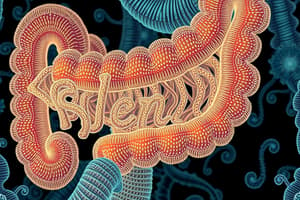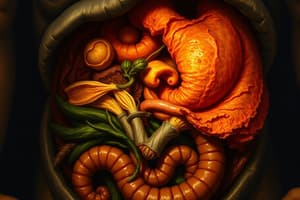Podcast
Questions and Answers
What feature of the villus primarily aids in accelerating nutrient absorption?
What feature of the villus primarily aids in accelerating nutrient absorption?
- A large surface area covered in mucus
- A thick epithelial layer
- An epithelial layer that is one cell thick (correct)
- A network of lymphatic vessels
Which of the following is NOT a function of the villi in the ileum?
Which of the following is NOT a function of the villi in the ileum?
- Transport of digestive products
- Production of bile (correct)
- Secretion of digestive enzymes
- Secretion of mucus
Why is the length of the ileum beneficial for absorption?
Why is the length of the ileum beneficial for absorption?
- It allows for more efficient breakdown of nutrients.
- It increases the surface area for absorption. (correct)
- It reduces the time food spends in the intestine.
- It facilitates faster passage of food through the digestive tract.
What purpose do microvilli serve on the surface of the villus?
What purpose do microvilli serve on the surface of the villus?
What role do lacteals play in the absorption process?
What role do lacteals play in the absorption process?
What substances are absorbed in the large intestine?
What substances are absorbed in the large intestine?
Which of the following correctly describes the function of faeces?
Which of the following correctly describes the function of faeces?
What role do bacteria in the colon play?
What role do bacteria in the colon play?
What triggers the need to expel faeces from the body?
What triggers the need to expel faeces from the body?
What effect can the consumption of antibiotics have on the colon?
What effect can the consumption of antibiotics have on the colon?
What is the primary function of the liver in the assimilation of digested food?
What is the primary function of the liver in the assimilation of digested food?
During the deamination process in the liver, what is excess amino acids converted into?
During the deamination process in the liver, what is excess amino acids converted into?
What does the hepatic portal vein primarily transport?
What does the hepatic portal vein primarily transport?
Which of the following substances does the liver expel during detoxification?
Which of the following substances does the liver expel during detoxification?
What is liver cirrhosis primarily caused by?
What is liver cirrhosis primarily caused by?
Which structure collects lymph from the lymphatic system before it enters the bloodstream?
Which structure collects lymph from the lymphatic system before it enters the bloodstream?
What role do amino acids play in liver function?
What role do amino acids play in liver function?
Which of the following functions is NOT performed by the liver?
Which of the following functions is NOT performed by the liver?
What happens to excess amino acids in the body?
What happens to excess amino acids in the body?
What is the primary function of glucose in the liver?
What is the primary function of glucose in the liver?
When glucose levels decrease in the blood, what process occurs?
When glucose levels decrease in the blood, what process occurs?
Which of the following describes the role of lipids in the body?
Which of the following describes the role of lipids in the body?
What is the main consequence of a maximum glycogen supply?
What is the main consequence of a maximum glycogen supply?
What components are mixed together when food enters the colon?
What components are mixed together when food enters the colon?
Which process describes the movement of digested food through the colon?
Which process describes the movement of digested food through the colon?
Which of these statements about amino acids is incorrect?
Which of these statements about amino acids is incorrect?
What is the primary function of microvilli in the small intestine?
What is the primary function of microvilli in the small intestine?
Which nutrients are absorbed directly into the blood capillaries from the ileum?
Which nutrients are absorbed directly into the blood capillaries from the ileum?
How are fatty acids and glycerol absorbed in the small intestine?
How are fatty acids and glycerol absorbed in the small intestine?
What mechanism is used for the absorption of glucose in the ileum?
What mechanism is used for the absorption of glucose in the ileum?
Which vitamins are absorbed through the lacteals of the small intestine?
Which vitamins are absorbed through the lacteals of the small intestine?
Which nutrient is transported to the liver via the hepatic portal vein?
Which nutrient is transported to the liver via the hepatic portal vein?
What process allows water to be absorbed in the ileum?
What process allows water to be absorbed in the ileum?
What is the role of the lymphatic system in nutrient absorption?
What is the role of the lymphatic system in nutrient absorption?
Which of the following nutrients is NOT absorbed into the blood capillaries from the ileum?
Which of the following nutrients is NOT absorbed into the blood capillaries from the ileum?
Where do the nutrients absorbed into the lacteals eventually enter the bloodstream?
Where do the nutrients absorbed into the lacteals eventually enter the bloodstream?
Flashcards are hidden until you start studying
Study Notes
Absorption of Digested Food
- Absorption occurs primarily in the ileum of the small intestine, where simple molecules from digested food are taken up.
- The ileum is long with a highly folded inner layer, featuring villi and microvilli that significantly increase surface area for nutrient absorption.
Adaptations of Villi
- The epithelial layer of each villus is only one cell thick, enhancing absorption rates.
- Goblet cells within the villi secrete mucus, facilitating digestion.
- Blood capillaries transport absorbed nutrients throughout the body, while lacteals carry fatty acids and fat-soluble vitamins.
- Intestinal glands secrete digestive enzymes via intestinal juices; microvilli further expand the surface area for absorption.
Nutrient Absorption Pathways
- Nutrients absorbed into blood capillaries: Water, glucose, amino acids, vitamins B and C.
- Nutrients absorbed into lacteals: Fatty acids, glycerol, vitamins A, D, E, and K.
- Glucose, galactose, fructose, amino acids, vitamins B and C, and water are absorbed through ileum epithelial cells into blood capillaries, then transported to the liver via the hepatic portal vein.
- Fatty acids and glycerol enter the lacteals by simple diffusion, recombine into lipids within epithelial cells, and are transported through the lymphatic system into the bloodstream.
Mechanisms of Nutrient Absorption
- Fructose: Facilitated diffusion.
- Glucose and Galactose: Active transport.
- Amino Acids: Active transport.
- Vitamins B and C, Water: Absorbed with water and via osmosis.
- Fatty Acids and Glycerol: Simple diffusion.
- Vitamins A, D, E, K: Also absorbed by simple diffusion as they dissolve in lipids.
Role of the Circulatory System
- The circulatory system comprises blood circulation and lymphatic systems to transport absorbed nutrients for assimilation.
- Blood capillaries in the small intestine converge to form the hepatic portal vein, directing blood to the liver.
- Lymphatic vessels collect from lacteals and transport lipids through the thoracic duct to the left subclavian vein.
Functions of the Liver in Assimilation
- Metabolism: Converts glucose for respiration, and amino acids into plasma proteins; excess amino acids undergo deamination to form urea.
- Detoxification: Eliminates toxic substances like drugs and alcohol from the blood.
- Storage: Stores excess glucose as glycogen, along with vitamins and mineral salts.
Liver Health and Diseases
- Liver cirrhosis results from alcohol, toxins, or hepatitis, leading to scar tissue formation and impaired liver function.
- Hepatitis is an inflammation of the liver caused by infections or toxins.
Assimilation Process
- Amino acids are used to synthesize proteins and enzymes or converted to urea in the liver.
- Glucose is utilized for energy through respiration and excess is stored as glycogen or converted to fats.
- Lipids contribute to cellular structures like membranes and are stored as energy reserves.
Functions of the Large Intestine
- Absorbs remaining water, vitamins, and metabolic byproducts, resulting in feces formation.
- Feces comprise water, dead cells, waste, and bacteria, exiting the body via the anus during defecation.
Bacteria in the Colon
- The large intestine hosts a diverse microbial community, crucial for decomposing food waste and synthesizing vitamins B12 and K.
- Maintaining a balance between beneficial and harmful bacteria is vital for health; antibiotics can disrupt this balance.
Studying That Suits You
Use AI to generate personalized quizzes and flashcards to suit your learning preferences.




